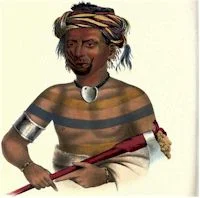
The import of this name is, the Man who killed three Sioux. Why he is so called will appear in the sequel. He is also called Moanahonga, which means Great “Walker. Shauhaunapotinia is an Ioway; and was, when his likeness was taken, in 1837, twenty-one years old.
It is customary among the Ioway for boys, when they arrive at the age of eight or ten years, to select companions of about the same age. A companionship, thus formed, ripens into a union which nothing but death is ever permitted to dissolve. The parties become inseparable; are seen together in their sports, and, in riper years, in the chase; and, when in battle, they are side by side. Their most confidential secrets are told without reserve to each other, and are afterwards treated as if confined but to one breast. Shauhaunapotinia had formed a fellowship of this abiding sort with an Ioway boy, which lasted till his companion had reached his nineteenth, and himself his eighteenth year, when the Sioux destroyed this endearing relationship by killing Shauhaunapotinia’s companion. This occurrence took place about one hundred miles from the nearest Sioux village. The moment the tidings of his friend’s death reached Shauhaunapotinia, he resolved on revenge. He went into mourning by blacking his face, and secretly left his village, and sought the enemy. Coming upon the Sioux in their encampment, of about four hundred lodges, he rushed in among them like a maniac, and, with his knife, stabbed a brave, whom he instantly scalped; then, rushing from the encampment in the direction of his village, he fell in with, and killed and scalped two squaws, bringing to his home three scalps; and all this was the work of twenty-four hours, the distance traveled in that time being one hundred miles! Hence his name the Sioux Killer, because of his success in killing and scalping three Sioux and the Great Walker, because of his having traveled over such an extent of country in so short a time.
On reaching his village, he made known where he had been, and what was his object, and showed the scalps in testimony of his triumph. On hearing his statement, and seeing his trophies, the chiefs and braves of his nation immediately bound round his legs, just below his knees, skins of the polecat, these being the insignia, of bravery. Young Mahaskah immediately adopted him as his friend, companion, and counselor; hence his presence with him at Washington city. To his bravery, Shauhaunapotinia added the qualities of a wit, and is represented as having no equal in the nation. His waggeries are so numerous, and so diversified, as to leave him master of all the circles of fan and frolic in which he mingles.
Shauhaunapotinia, when he joined Mahaskah, was destined, for the first time in his life, to see and be among white people. On arriving at Liberty, Clay county, Missouri, he gave signs of great uneasiness. On one occasion, he came running to the agent in great trepidation, without his blanket, saying, “Father, these white people are fools.” “Why do you call them fools?” asked the agent. “Why,” replied the Sioux Killer, “they make their fires in the wrong part of their wigwams; why don’t they make them, as we do, in the middle? I am almost frozen. And that,” he continued, “is not all; the white people look at me; may be they want to kill me. I want to go home.” The agent explained to him that the fire was built where all white people build it, at one end of their wigwam; and, assuring him that the whites were only carious, and had no unkind intentions towards him, he became reconciled, and agreed to proceed. He gave signs, however, of affliction, by blacking his face, and sitting quietly by himself in some lone place for two days.
We have, in this anecdote, an illustration of the truth, that, before the mind can bring itself to stand un-applied before danger, it must become accustomed to it; and, not only to danger in the abstract, but to its variety, and under all its forms. Now, here was an Indian, who, to revenge the death of his friend, could travel, alone and undismayed, a hundred miles into the enemy’s country, rush into an encampment of four hundred lodges, strike down a brave and scalp him, and return, killing two other Indians by the way; and yet, when placed in a new country, amidst other than his forest scenes, and among a people of another color, of whom he knew nothing, he was made to tremble and be afraid at a look! The same knowledge of the white man, the same acquaintance with his habits, and mode of warfare, and especially the opportunity of measuring arms with him in a fight or two, would have elevated this Indian’s courage to an equal height to which it proved itself capable of rising when he made that desperate attack upon the Sioux in their own encampment. Some writer, we remember, in speaking of the fearless character of the British seamen, says, “Brave, because bred amidst dangers great, because accustomed to the dimensions of the world.” It is highly probable that, were a seaman taken from the bravest of the brave, and conveyed away from the ship, with whose strength and power he had become familiar, and placed in a wilderness, among savages, he would shrink from their scrutiny, and realize a depression in the scale of his courage, as did the Sioux Killer when removed from the theater of his victories, and conveyed among a people who were new to him, and of whom he knew nothing.
Discover more from Access Genealogy
Subscribe to get the latest posts sent to your email.
